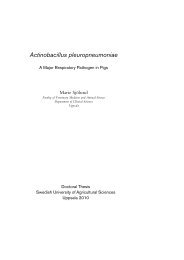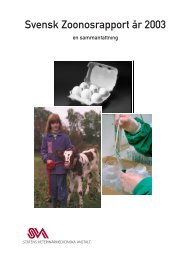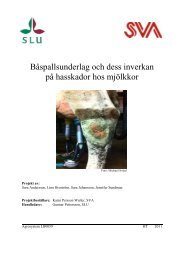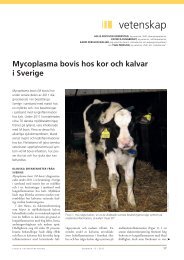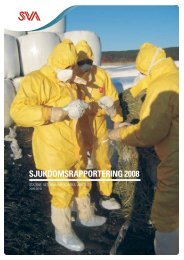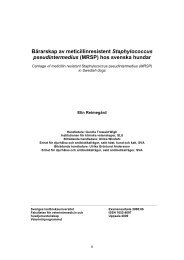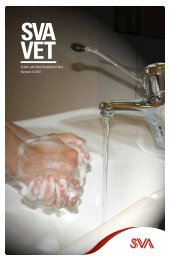Revision ISO 10272 Detection and enumeration of ... - SVA
Revision ISO 10272 Detection and enumeration of ... - SVA
Revision ISO 10272 Detection and enumeration of ... - SVA
- No tags were found...
Create successful ePaper yourself
Turn your PDF publications into a flip-book with our unique Google optimized e-Paper software.
<strong>ISO</strong> <strong>10272</strong><strong>Detection</strong> <strong>and</strong> <strong>enumeration</strong> <strong>of</strong>Campylobacterin food <strong>and</strong> animal feeding stuffs- <strong>Revision</strong> -Enne de BoerAHG Campylobacter
<strong>Revision</strong> EN <strong>ISO</strong> <strong>10272</strong>-1:2006 & <strong>ISO</strong>/TS <strong>10272</strong>-2:2006<strong>ISO</strong>/TC 34/SC 9 meeting in Valencia (2009):1. SC9 members decided to launch a revision <strong>of</strong> EN <strong>ISO</strong><strong>10272</strong>-1:2006 to improve the enrichment <strong>and</strong> confirmationsteps <strong>and</strong> microaerobic incubation conditions.2. SC9 members decided to transform <strong>ISO</strong>/TS <strong>10272</strong>-2:2006into an EN <strong>ISO</strong> st<strong>and</strong>ard including a modification <strong>of</strong>confirmation steps.2
Ad Hoc Group CampylobacterBelgium: Nadine BotteldoornFrance: Marie-José LaisneyGermany: Kerstin StinglItaly: Vincenza Prencipe, Elisabetta Di GiannataleNetherl<strong>and</strong>s: Wilma Jacobs-Reitsma, Ida Jongenburger,Enne de BoerSweden: Ingrid HanssonUK: Janet Corry, Mary Howell, Ana Vidal, John Rodgers3
Ad Hoc Group Campylobacter17/18 April 2012NVWAUtrecht (NL)4
EnrichmentAd Hoc Group Campylobacter - proposalsProposal: choice <strong>of</strong> two enrichment procedures depending on thematrix<strong>ISO</strong> <strong>10272</strong>-1A: detection <strong>of</strong> Campylobacter in foods with lowbackground count <strong>of</strong> non-campylobacters <strong>and</strong>/or with stressedcampylobacterse.g. cooked or frozen products contaminated with CampylobacterProcedure: enrichment in Bolton broth, microaerobic incubation 4-6 h at 37ºC, 40-48 h at 41,5ºC;isolation on mCCDA <strong>and</strong> a 2 nd medium6
EnrichmentAd Hoc Group Campylobacter - proposalsProposal: choice <strong>of</strong> two enrichment procedures depending on thematrix<strong>ISO</strong> <strong>10272</strong>-1B: detection <strong>of</strong> Campylobacter in foods with highbackground count <strong>of</strong> non-campylobacterse.g. raw chicken, raw meats, raw milkProcedure:1) enrichment in Preston broth, microaerobic incubation 24 h at41,5ºC; isolation on mCCDA2) direct plating from sample homogenate on mCCDA7
EnrichmentAd Hoc Group Campylobacter - proposalsProposal: choice <strong>of</strong> two enrichment procedures depending on thematrix<strong>ISO</strong>/TC 34/SC 9 meeting, Buenos Aires (2010): OK8
Ad Hoc Group Campylobacter - proposalsIsolation medium<strong>ISO</strong> <strong>10272</strong>-1:2006 - It is preferable to take a second isolationmedium that is based on a principle different from mCCDA.Examples <strong>of</strong> isolation media to be used are Skirrow agar,Karmali agar <strong>and</strong> Preston agarMost <strong>of</strong> the current available alternatives for mCCDA are notprincipally different, <strong>and</strong> the use <strong>of</strong> these media does not havean added value in most cases.<strong>ISO</strong>/TC 34/SC 9 meeting, Buenos Aires (2010): Make furtherinvestigation concerning the interest <strong>of</strong> using two differentmedia for the isolation step9
Ad Hoc Group Campylobacter - proposalsEnumeration (<strong>ISO</strong> <strong>10272</strong>-2)Plating <strong>of</strong> initial suspension <strong>and</strong> decimal dilutions according to <strong>ISO</strong>7218:2007, so not in duplicateRevise the counting <strong>of</strong> low numbers. When low counts areexpected: 1 ml <strong>of</strong> initial suspension on a large or 3 small agardishes, in duplicate10
Ad Hoc Group Campylobacter - proposalsConfirmation tests- Delete: “Aerobic growth at 41,5ºC”, as some campylobactersshow limited growth at 41,5ºC- Change “Microaerobic growth at 25ºC” in “Aerobic growth at25ºC”- Microscopic examination can be done directly from colonies onblood agar or mCCDA; suspension in Brucella broth is notneeded<strong>ISO</strong>/TC 34/SC 9 meeting, Buenos Aires (June 2010): OK11
Ad Hoc Group Campylobacter - proposalsIdentification tests (optional)Delete the antibiotic sensitivity tests for nalidixic acid <strong>and</strong>cephalothin, because <strong>of</strong> increased resistance <strong>of</strong> some species forthese antibioticsAdd a recommendation to use alternative confirmation tests, suchas PCR, immunological tests, microarray, etc.12
Ad Hoc Group CampylobacterCEN/TC 275/WG 6 meeting, 2011,Bournemouth, UKCEN/TC275/WG6 asked the project leader to prepare the finaldrafts for parts 1 <strong>and</strong> 2 for the next CEN/TC275/WG6 meeting<strong>and</strong> to reply to the following questions:- Optimum incubation time for Preston broth- Ratio <strong>of</strong> headspace to enrichment volume- Addition <strong>of</strong> blood (0, 1 or 5%) to enrichment media- Do Preston or Bolton broth select for different Campylobacterspecies- Should skin or pieces <strong>of</strong> meat be separated from enrichmentbroth by the use <strong>of</strong> filter bags13
Microaerobic incubationmicroaerobic atmosphere withoxygen content 5 % 2 %carbon dioxide 10 % 3 %optional hydrogen ≤10 %with the balance nitrogen<strong>ISO</strong> <strong>10272</strong>-1:20066.14NOTE 2As an alternative to incubation in a microaerobic atmosphere, theenrichment can be incubated in screw-capped bottles or flasks filledwith enrichment broth, leaving a headspace <strong>of</strong> less than 2 cm, <strong>and</strong>tightly closing the caps.
Earlier proposal:Microaerobic incubationNOTE 2 As an alternative to incubation in a microaerobicatmosphere, the enrichment can be done in tightly closed containersfilled with enrichment broth, leaving a headspace <strong>of</strong> about 20% <strong>of</strong> thetotal volume <strong>of</strong> the container.Proposed text:NOTE 2As an alternative to incubation in a microaerobic atmosphere, theenrichment can be done in tightly closed containers filled withenrichment broth <strong>and</strong> having a reduced headspace.This alternative should only be applied, when there is sufficientevidence <strong>of</strong> the creation <strong>of</strong> correct microaerobic conditions.Final proposal:Delete the note, as it is impossible to st<strong>and</strong>ardize microaerobic incubationby using bottles with reduced headspace.
Questions from CEN/TC 275/WG 6- Optimum incubation time for Preston broth – 24 h- Ratio <strong>of</strong> headspace to enrichment volume – no mention <strong>of</strong> theuse <strong>of</strong> reduced headspace- Addition <strong>of</strong> blood (0, 1 or 5%) to enrichment media – Bolton +5% blood + FBP; Preston broth + 5% blood- Do Preston or Bolton broth select for different Campylobacterspecies – not clear at the moment- Should skin or pieces <strong>of</strong> meat be separated from enrichmentbroth by the use <strong>of</strong> filter bags – better in e.g. <strong>ISO</strong> 688716
<strong>ISO</strong> <strong>10272</strong>-4: Samples from primary production(from animals <strong>and</strong> their environment)For the development <strong>of</strong> part 4 <strong>of</strong> EN <strong>ISO</strong> <strong>10272</strong>, CEN/TC275/WG6asked the Project Leader to liaise with TAG5 (meeting AHVLA,20/21 October 2011)Samples from primary production:- <strong>Detection</strong> bydirect plating (e.g. caecal samples) acc. <strong>ISO</strong> <strong>10272</strong>-1B<strong>ISO</strong> <strong>10272</strong>-1A or <strong>ISO</strong> <strong>10272</strong>-1B (depending oncontaminating micr<strong>of</strong>lora)- Enumeration using <strong>ISO</strong> <strong>10272</strong>-2
<strong>ISO</strong> <strong>10272</strong>-1: detectionproposal- Is there a need for a separate part 4 for the analysis <strong>of</strong>samples from primary production?- The parallel use <strong>of</strong> enrichment in Preston broth <strong>and</strong> directplating as described in <strong>ISO</strong> <strong>10272</strong>-1B is not very practical
<strong>ISO</strong> <strong>10272</strong>-1: detectionproposal<strong>ISO</strong> <strong>10272</strong>-1A: <strong>Detection</strong> <strong>of</strong> Campylobacter by enrichment inproducts with low numbers <strong>of</strong> campylobacters <strong>and</strong> low level <strong>of</strong>background micr<strong>of</strong>lora <strong>and</strong>/or with stressed campylobacters, e.g.cooked or frozen products<strong>ISO</strong> <strong>10272</strong>-1B: <strong>Detection</strong> <strong>of</strong> Campylobacter by enrichment inproducts with low numbers <strong>of</strong> campylobacters <strong>and</strong> high level <strong>of</strong>background micr<strong>of</strong>lora , e.g. raw meats or raw milk<strong>ISO</strong> <strong>10272</strong>-1C: <strong>Detection</strong> <strong>of</strong> Campylobacter by direct plating inproducts with high numbers <strong>of</strong> campylobacters, e.g. faeces,poultry caecal contents or raw poultry meat.19
20<strong>ISO</strong> <strong>10272</strong>-1A: detectionproposal
21<strong>ISO</strong> <strong>10272</strong>-1B: detectionproposal
22<strong>ISO</strong> <strong>10272</strong>-1C: detectionproposal
Direct plating on selective agar<strong>ISO</strong> <strong>10272</strong>-1C: detectionproposal-For caecal <strong>of</strong> faecal samples use a loop or a sterile swab tobring some <strong>of</strong> the well-mixed sample material onto the first half<strong>of</strong> a mCCDA plate. Use another loop to streak out on the secondhalf <strong>of</strong> the plate.-For all other samples, add an appropriate amount <strong>of</strong> liquid (e.g.MRD or Preston broth), for example 1 to 1 w/w, mix well, <strong>and</strong>either streak the plate using a loop, or dispense a suitablevolume <strong>and</strong> spread it over the mCCDA plate.23
Further development <strong>of</strong> revised <strong>ISO</strong> <strong>10272</strong>-1 + 2The drafts have been discussed during CEN/TC275/WG6 meeting,Brussels (June 2012) <strong>and</strong> it was decided- to launch a NWIP (new work item proposal) vote for theoptions 1A, 1B <strong>and</strong> 1C <strong>of</strong> <strong>ISO</strong> <strong>10272</strong>-1- to launch a NWIP for a full EN <strong>ISO</strong> st<strong>and</strong>ard (not TS) for <strong>ISO</strong><strong>10272</strong>-2The voting period (3 months) will start in November 2012.Any technical comments should be submitted at this stage.
Validation <strong>of</strong> revised <strong>ISO</strong> <strong>10272</strong>-1 + 2If the NWIP will be approved, then validation by interlaboratorystudies can start (CEN m<strong>and</strong>ate M/381)In the current planning the first validation study will be in earlyspring 2013 <strong>and</strong> will be on <strong>ISO</strong> <strong>10272</strong>-2 (<strong>enumeration</strong>)Projectleaders: Enne de Boer (part 1), Wilma Jacobs (part 2)in collaboration with EURL Campylobacter
Thank you for your attentionenne.de.boer@vwa.nl


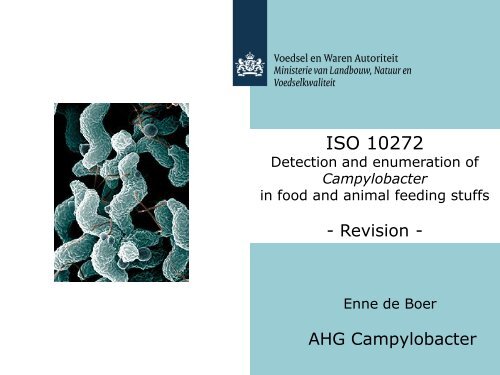
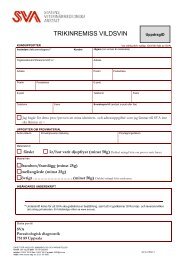
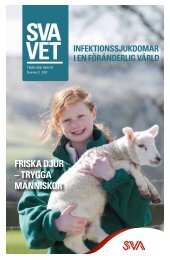
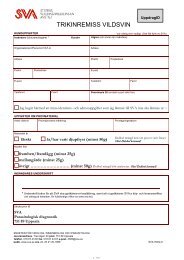
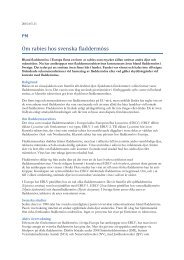
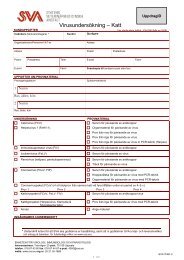
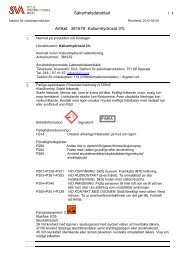
![Uppsala nfo z NRL pro kampylobaktery .ppt [režim kompatibility] - SVA](https://img.yumpu.com/48904877/1/190x135/uppsala-nfo-z-nrl-pro-kampylobaktery-ppt-rea-3-4-im-kompatibility-sva.jpg?quality=85)
